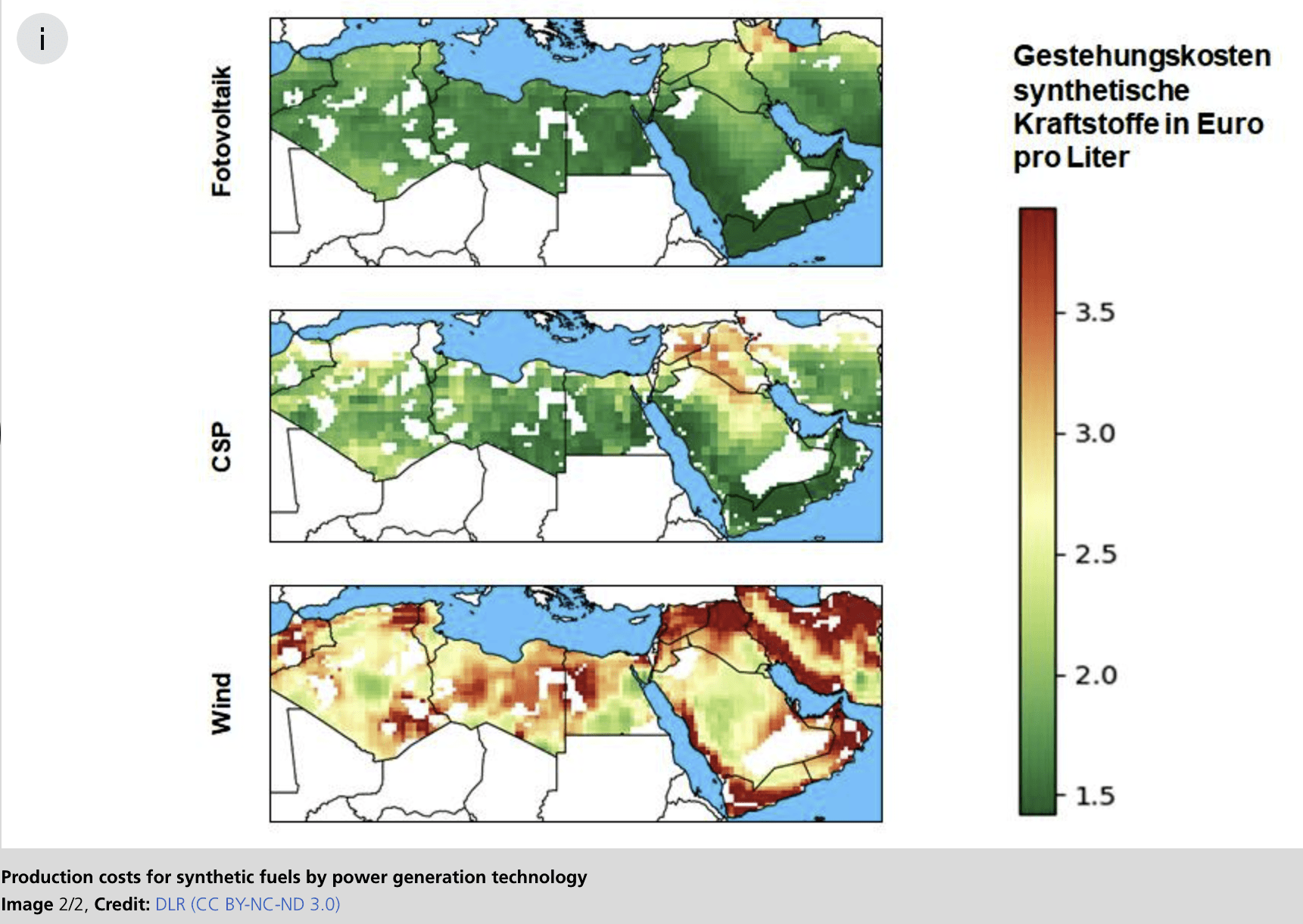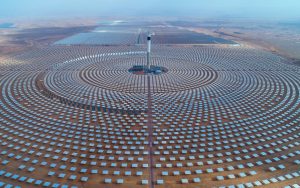MENA synthetic fuels potential: The North Africa and Middle East region has the potential to manufacture low cost synthetic fuels made with solar – PV or CSP – for under 2 euros in production.
- The Middle East and North Africa (MENA) region has great potential to produce hydrogen and synthetic fuels from renewable resources.
- Together with partners, DLR has presented a comprehensive technical and economic analysis in the MENA Fuels study.
- Synthetic fuels play an important role in reducing CO₂ emissions in the mobility sector and in achieving ambitious climate protection goals.
- Focus: energy, energy transition, climate change, hydrogen
The German Aerospace Center (DLR) Wuppertal Institute and the Institute for Future Energy and Material Flow Systems(IZES) have in a study investigated what role the Middle East and North Africa could play in supplying Germany and Europe with hydrogen and synthetic fuels from renewable resources. The results show that the MENA (Middle East and North Africa) region has enormous potential and enables cost-effective production. In addition to the renewable resources, the production costs (production costs) are also significantly dependent on investment risks – and thus on a wide range of boundary conditions in possible export countries. Synthetic fuels play an important role in reducing CO 2-Reduce emissions in the mobility sector and achieving ambitious climate protection goals. To produce them, electricity and hydrogen from renewable sources as well as carbon from the air are used.
For the first time, MENA region high-resolution data on technical potential, production costs, and the investment environment combined
For the study, the researchers examined the entire MENA region with high resolution for the first time. To do this, they divided the area into many small areas and evaluated them individually. Also new: the authors have modeled the entire production chain for synthetic fuels and integrated them into their calculations. Energy and hydrogen storage were also part of the consideration. They are necessary and useful to operate the entire system with renewable and thus fluctuating resources in a stable and economically optimal manner. In contrast to other studies, MENA-Fuels combines technological and economic aspects with the assessment of individual country risks for all 17 countries considered in this region. This included analyzes of the resources, the political framework, and the framework for investments. “For the first time we have a comprehensive analysis – as a basis for further research work, but also as a source of information and basis for decision-makers in industry and politics,” summarizes Jürgen Kern, project manager for the study at the DLR Institute for Networked Energy Systems.
Technical potential analysis: MENA synthetic fuels production could exceed Germany’s requirements many times over
With more than 400,000 terawatt-hours per year, the MENA region has a large generation potential for renewable energies. This applies above all to the use of solar energy in the form of photovoltaics and concentrated solar power (CSP). The potential for producing hydrogen and synthetic fuels is correspondingly large. This is true even if you subtract the long-term self-consumption of the MENA countries from the complete conversion to renewable energy. Depending on the assumed development scenario – negative, conservative, positive – the export potential could exceed the German demand for synthetic fuels by a factor of 60 to 1,200.

In the MENA region, both PV and CSP could produce hydrogen at lower costs than wind
Cost analysis: Significant MENA potential for synthetic fuels for less than two euros per liter in production
Almost all MENA countries show significant potential for producing synthetic fuels at low production costs. At the cheapest locations, the production costs could be between 1.92 and 2.65 euros per liter in 2030 – and in 2050 between 1.22 and 1.65 euros per liter. For these figures, the researchers assumed investment costs in the medium range and assumed a positive development in investment conditions. The export potential of synthetic fuels, which could be produced for less than two euros per liter, is around 28,000 terawatt hours in 2050, even with negative investment conditions. In this case, it would mainly come from countries with good technical potential and stable conditions.
The investment environment decides on potential export regions
However, not only the production costs but also the investment environment are decisive for the assessment of the export potential. If one considers possible investment risks, this significantly influences the total costs and thus the possible selection of export countries.
In addition, a prerequisite for the export of synthetic fuels in each scenario is the comprehensive expansion of renewable energies in the MENA region itself. At present, such magnitudes and the necessary expansion dynamics are not yet reflected in the expansion targets of most MENA countries. In addition to building production capacities for synthetic fuels on an industrial scale, the expansion of renewable energies would also have to be significantly intensified. Ideally, domestic supply and export complement and reinforce each other. The German Aerospace Center (DLR)Wuppertal Institute and theInstitute for Future Energy and Material Flow Systems(IZES) have in study investigates what role the Middle East and North Africa could play in supplying Germany and Europe with hydrogen and synthetic fuels from renewable resources. The results show that the MENA ( Middle East and North Africa ) region has enormous potential and enables cost-effective production. In addition to the renewable resources, the production costs (production costs) are also significantly dependent on investment risks – and thus on a wide range of boundary conditions in possible export countries. Synthetic fuels play an important role in reducing CO 2-Reduce emissions in the mobility sector and achieving ambitious climate protection goals. To produce them, electricity and hydrogen from renewable sources as well as carbon from the air are used.



